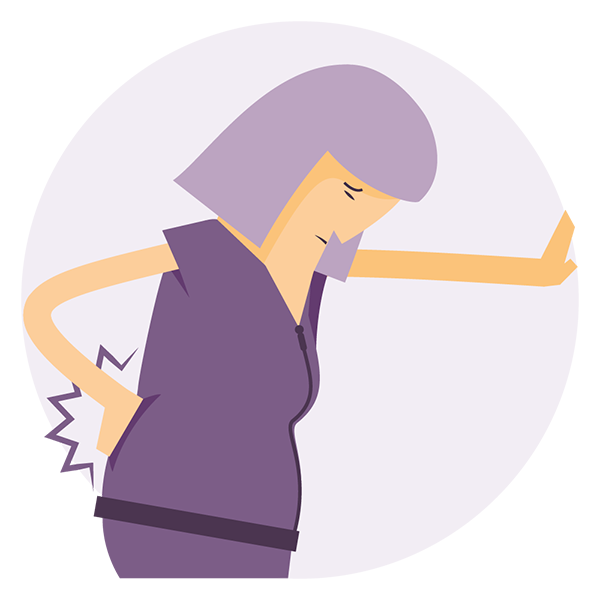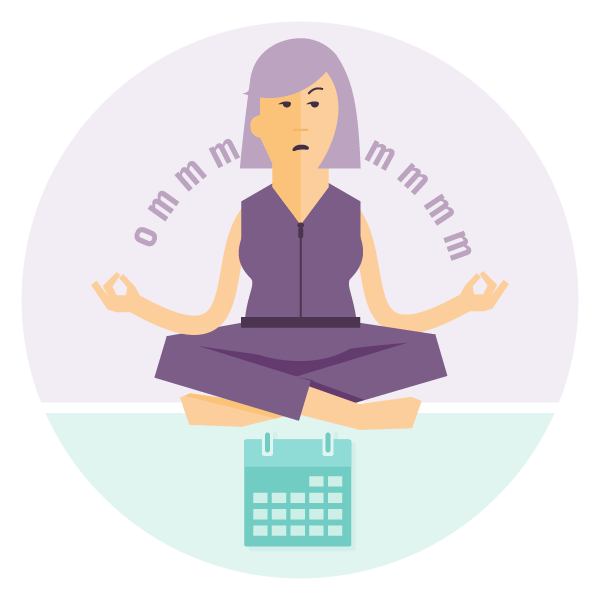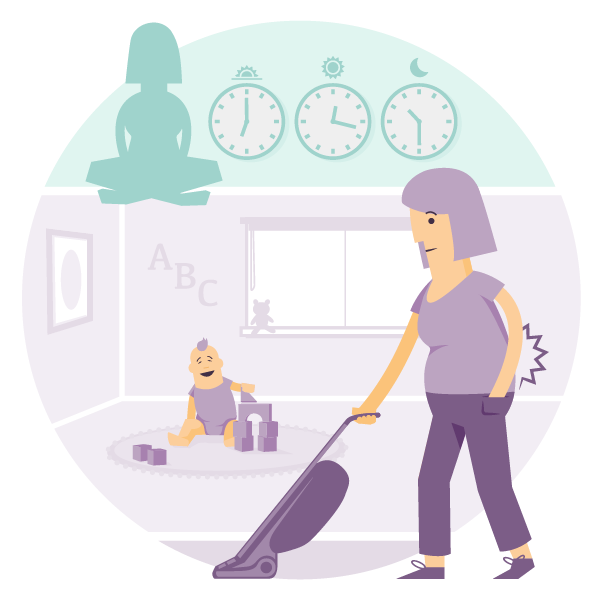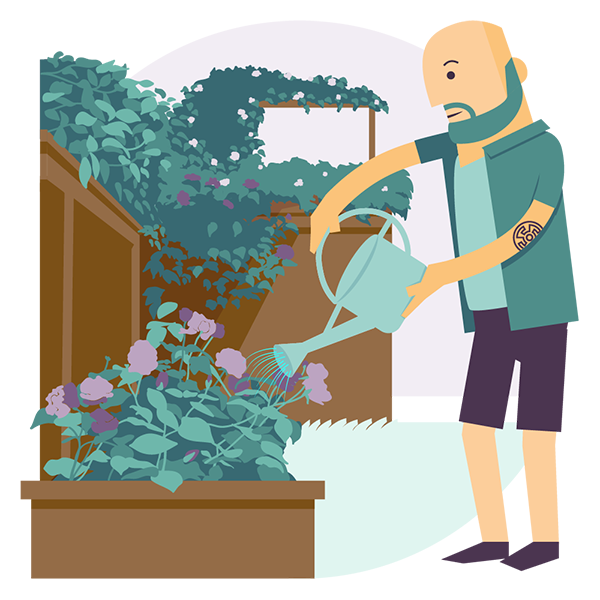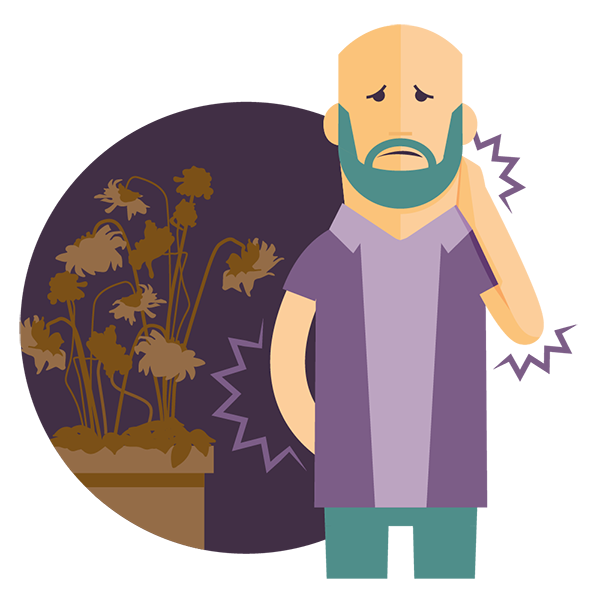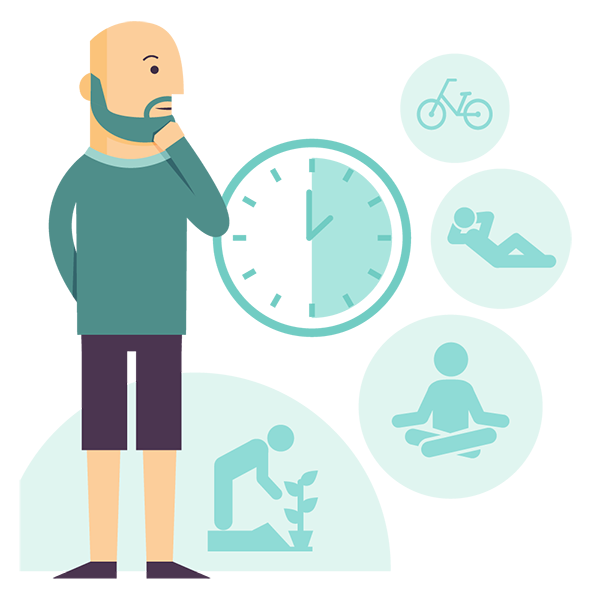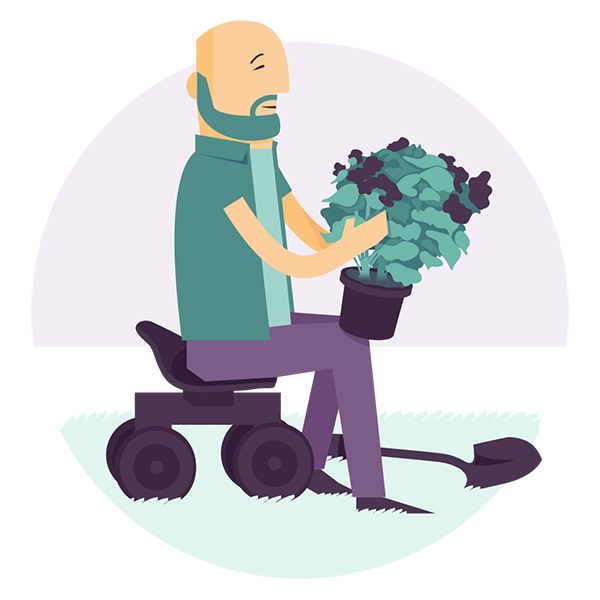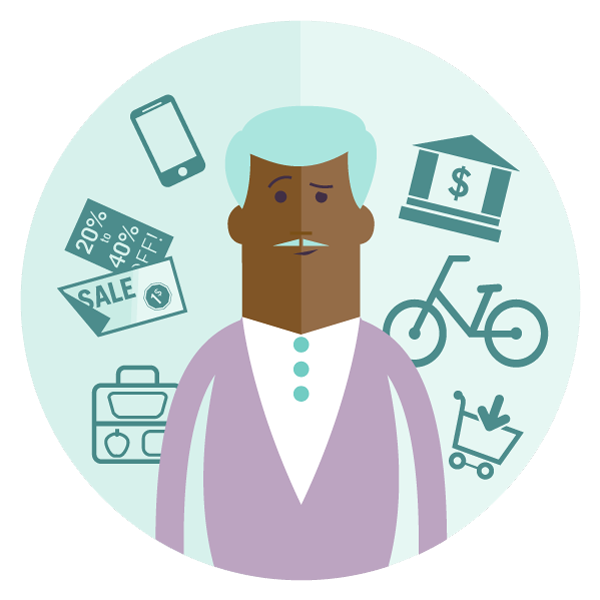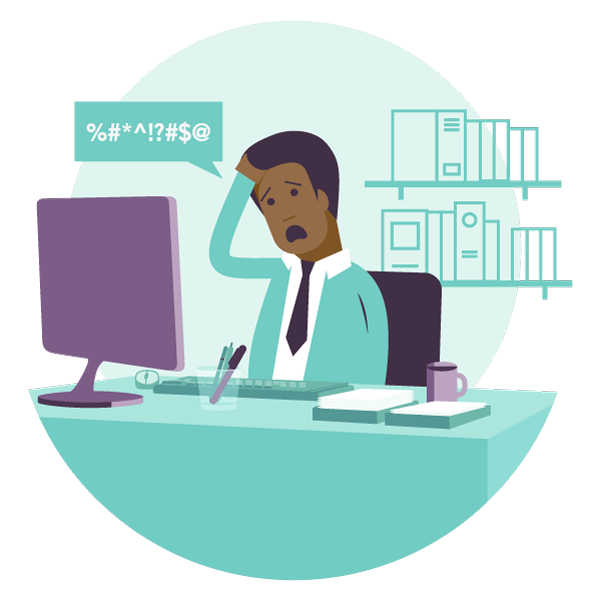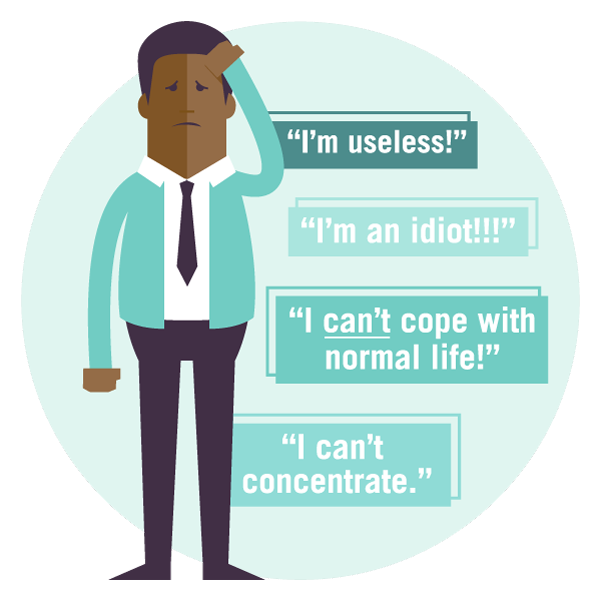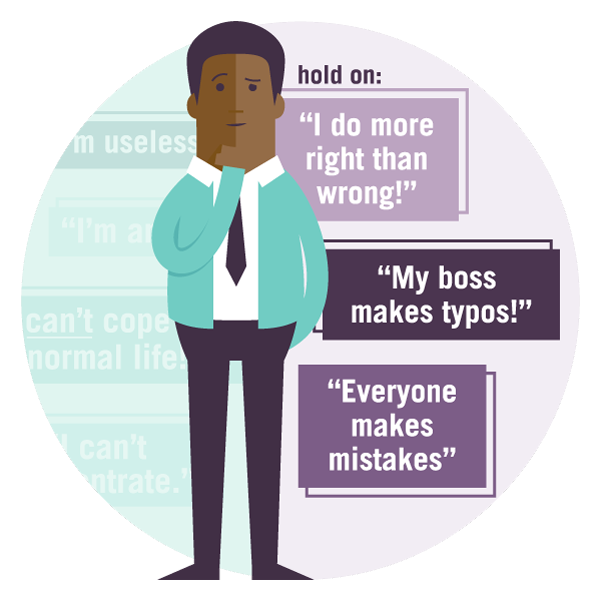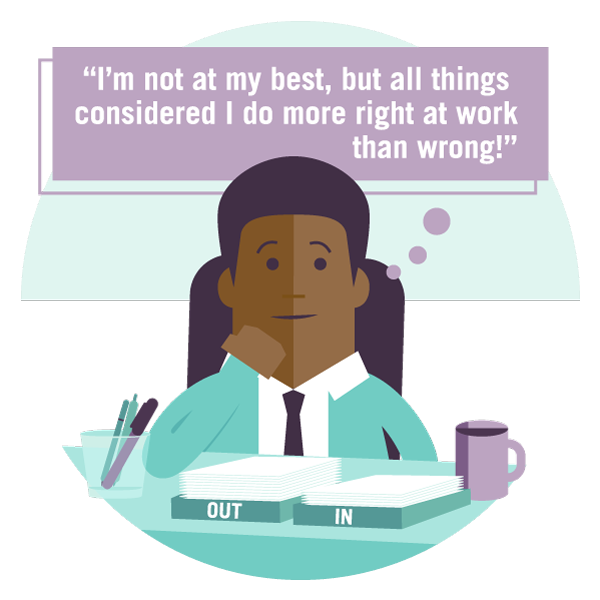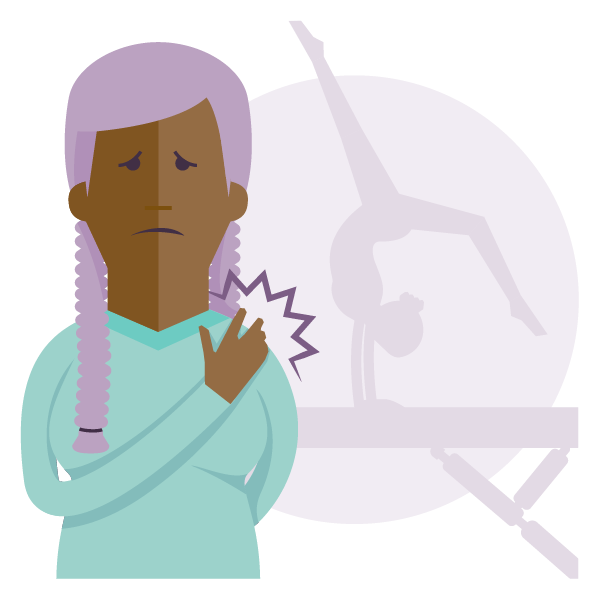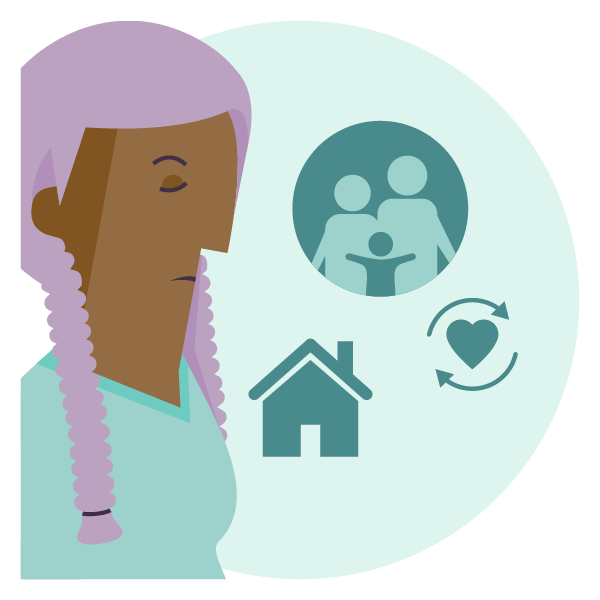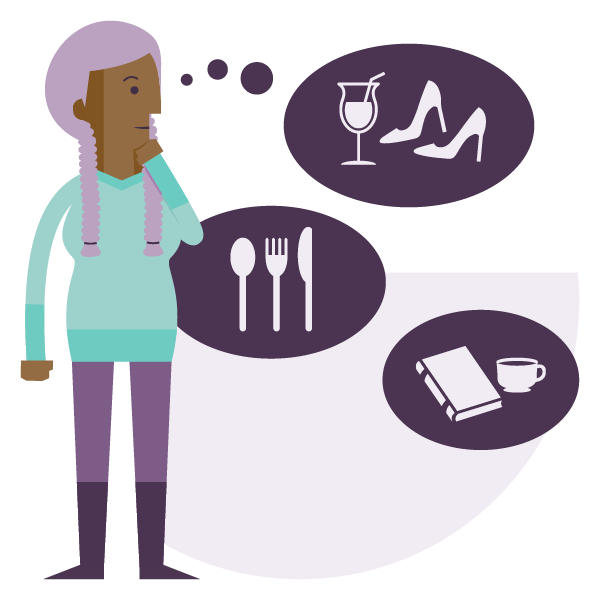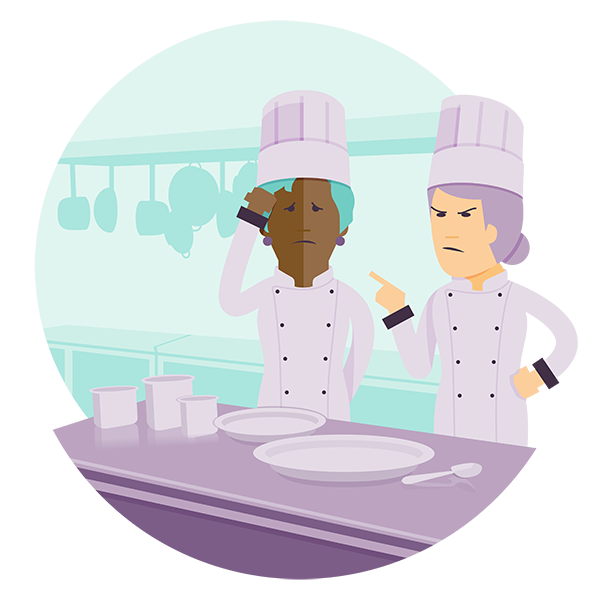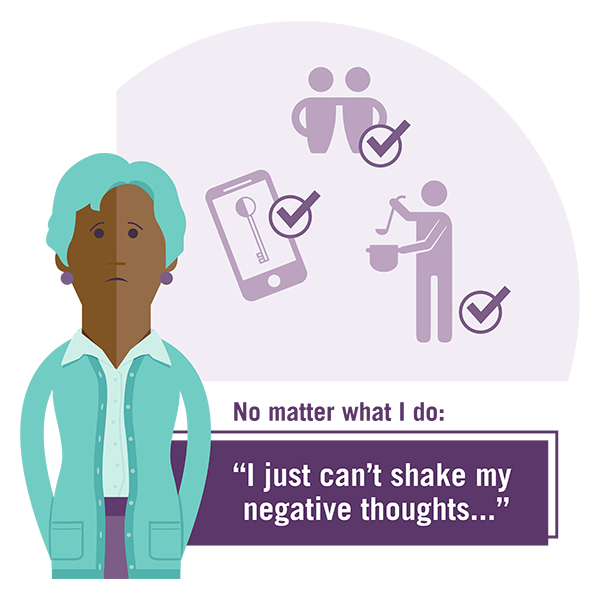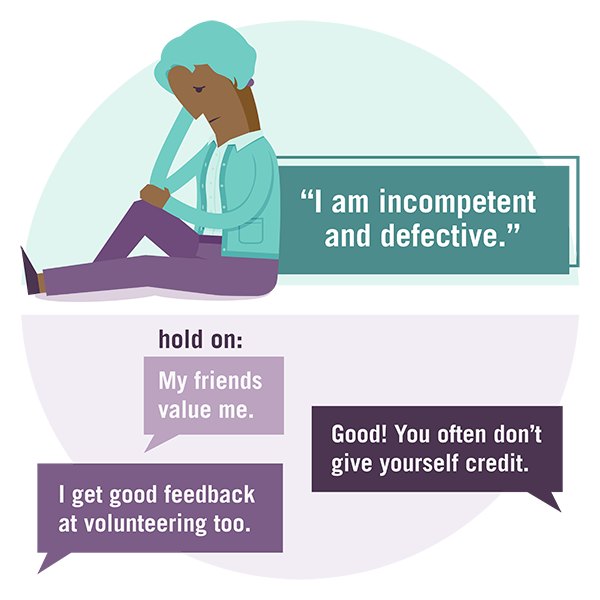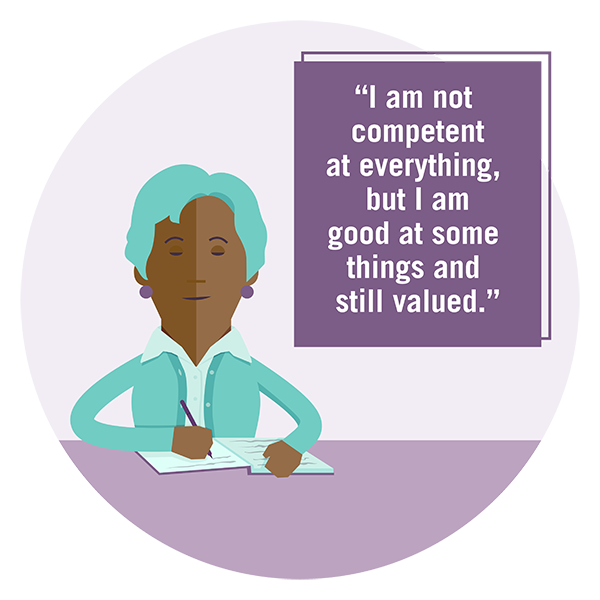Chronic Pain
Chronic pain is common. About 1 in 5 young people and adults live with chronic pain. The good news is that there are effective treatments that can help you cope. Here you will learn more about chronic pain and how to manage it.
You can use any lesson at any time. However, therapy for chronic pain usually uses this order:
Learn the facts about chronic pain -- what it is and most importantly, how it's treated.
Learning to experience your body without judgment can help you cope with your pain.
Chronic pain can make it hard to get things done. Learn how to balance activities and breaks and stay on top of life's tasks.
When you've got a problem, you need to do more than challenge negative thoughts. Here you'll learn how to cope in these situations.
Beliefs about chronic pain can keep you stuck. Here you'll learn how to reframe your views so you can start moving forward.
In this unit, you will learn how you can feel better by challenging the thoughts that bring you down.
You can still have a full life despite your pain. Knowing your values will help you find meaningful goals.
When certain thoughts seem immune to challenging, a core belief might be keeping you stuck. Here you’ll learn how to rework them.
Keep practicing. Download reusable worksheets and other tools to keep you going.
What is Chronic Pain?
5minIt’s normal to feel pain when you get injured. But when the pain lingers and starts to interrupt your daily routine, it can take over your life. People who have chronic pain can experience seemingly nonstop physical discomfort. Sometimes events will set off chronic pain when you aren’t expecting it. You might feel not only pain but also feel demoralized.
New skills can help you cope with chronic pain. You can learn to manage pain and have a meaningful life.
- The Facts
- Understanding Chronic Pain
- The Symptoms
- Treatment
! For your privacy, this site does not save what you type. To save it or have a therapist review it, please download your work at the end of your session.
The Facts
It’s Common
Have you had pain several times this week? Has the pain been occurring for 6 months or more? If so, you may suffer from chronic pain, but you are not alone. Chronic pain affects millions of people. It can happen to anyone and occurs in 20 percent of the population.
It’s Treatable
You might feel that there is nothing that will help with your chronic pain. But treatment can help you learn to manage it. You can develop a new relationship with pain and cope more easily when pain occurs.
Useful Pain
The human body is always taking in information. What’s the temperature? How’s the pressure? Is it soft or rough? These sensations get interpreted in our brain.
Pain involves the translation and transformation of sensory information deemed dangerous. If you cut your finger when you are preparing a meal, your senses give you several pieces of information. You might see a spot of blood on your finger and smell a distinct metallic tang. You may feel a tearing sensation at the site of the cut. Your nerves transmit all this information to your brain. The brain interprets the sensations as danger and then, finally, as pain.
The purpose of this kind of pain, acute pain, is to let you know you have an injury and to prevent further damage. It’s a useful tool we use to protect our bodies. Now that you are aware of your cut finger, you can clean it, cover it, and make sure it heals quickly.
When Pain Becomes a Problem
Physical pain has its place in our lives. It might feel terrible, but it’s short-lived and gives us a useful signal that damage is occurring. Pain becomes problematic when it no longer keeps us from suffering further injury.
Pain is only useful when we can do something to stop more damage from happening. People who have arthritis may have lots of pain, but no medical options to cure the disease. In this way, chronic pain signals damage, but without the benefit to help to stop it.
Other forms of chronic pain may result from faulty signals. An error can happen a few different ways. Your nerves might be damaged and send wrong information to your brain. Alternatively, your brain may be hypersensitive and read the most gentle sensations as dangerous. No matter the underlying cause, your pain is a false alarm.
Chronic pain can be challenging to understand. The cause of the pain might even seem mysterious to you and your healthcare provider. Chronic pain might emerge from an injury that has healed or without a known injury at all. It might occur more often, last longer, and be more intense than acute pain.
In the past, our understanding of pain was that it developed because of an underlying physical cause. We now understand that pain can be felt even in the absence of a known root. You may have felt misunderstood or dismissed in the past. Know that your pain is real. Whether the cause is known or a complete mystery, your pain is real.
Gate Control and Neuromatrix Theories of Pain
Most people think about pain as a direct result of an injury. You might assume the worse the damage, the worse the pain. How you feel emotionally may not factor into it at all. However, the Gate Control Theory completely changes how we think about pain.
The Gate Control Theory suggests that our thoughts and emotions can influence our pain experience. The idea is that a structure in our spinal cord acts as a gate. If the gate is open, we can experience intense pain. If the gate is closed, the intensity is much lower. The theory says that the gate is more likely to be open if we are experiencing emotions that are challenging to us. You will feel more pain if you are feeling distressed or anxious than relaxed. Similarly, if you expect something to hurt, it will. On the other hand, if you are distracted or having pleasant emotions, you are less likely to feel pain.
Gate Control Theory may not explain everything about pain, but it does change our outlook. This theory helps us to understand why your relationship with pain matters. The pain you feel is not just a result of an injury. What you think and how you react to pain, play a role.
Another theory that changes how we think about pain is the Neuromatrix Theory. In the past, we imagined pain as stemming directly from injury or inflammation. Now we believe that pain results from a complex network in the brain called the Neuromatrix. This theory suggests that pain can come from any signal that the brain sees as a threat. You don’t need a physical injury to feel pain.
Other Symptoms of Chronic Pain
Most people only think about the physical symptoms of chronic pain, but it can also affect you in other ways.
When dealing with chronic pain, people often have negative thoughts. The worst might seem inevitable. You might think that your pain is endless, and nothing will ever help. Your thoughts might be made up of ideas like "unless I can completely get rid of my pain, my life is unlivable." You may believe that no one understands you or your pain. Perhaps you feel that pain affects you differently from other people, making you weak.
It's normal to want to avoid feeling pain. But when pain is chronic, you might stop doing a lot of things that once brought you joy. You might stop doing physical activities because you associate them with pain. Social events can also become difficult. You may avoid them due to the logistics of attending. Maybe you are just sick of answering the question "How are you?". When you stop seeing your friends, you might find less healthy ways of relaxing. You may start overeating or sleeping. Your use of alcohol or other substances might become excessive. Or maybe you are passing the days online shopping.
It's reasonable to change what you do in response to your pain. But you don't want to increase your pain by losing muscle strength from lack of exercise. Avoiding your social life can lead to loneliness and feeling isolated. Dependence on substances or compulsive behaviors can lead to more stress in the long run.
Chronic pain can trigger a range of emotional reactions. You might feel ashamed, afraid, or abandoned. You may become frustrated if you have had chronic pain for a long time. It is common to feel fed-up with yourself or your healthcare providers. You might believe your chronic pain will never improve. These thoughts might leave you feeling hopeless or helpless. Chronic pain can often lead to tough, difficult emotions. This stress can make your pain even worse.
Treatments
The good news is that treatment for chronic pain can help. New skills can help you cope more easily with the pain you experience.
Remember that physical pain can happen for many reasons. It’s important to work with your family doctor or healthcare professional when you have a pain condition.
There are many types of psychotherapy or talk therapy. Kelty's Key is based on cognitive behavioral therapy. This treatment helps you to think differently about your pain. A change in mindset can help you cope more easily with your pain. As your skills increase, so will your sense of mastery over your pain condition.
Well Done. You’re on Your Way.
You’ve taken the first step and learned about chronic pain. Knowledge is important. Understanding what chronic pain is and how it works will help you moving forward.
Mindfulness
15minIt’s natural to want your pain to go away. But the stress and anxiety that comes with wishing for change can backfire. It can cause your pain to become more intense and pull you into a cycle of despair and worry. Mindfulness can help you change the relationship between your mind and body. The practice of welcoming your experience, whether it is pleasant or not, can help you become less reactive to your pain.
- What is Mindfulness
- Mindfulness and Chronic Pain
- Types of Practice
- Overcoming Obstacles
! For your privacy, this site does not save what you type. To save it or have a therapist review it, please download your work at the end of your session.
What is Mindfulness?
Life will always bring ups and downs. You might not have a say in what happens to you, but you can learn to control how you react. Sometimes, this can make all the difference. Allowing yourself to spiral emotionally can make you feel a lot worse than the experience itself. Mindfulness is an ancient meditation technique for dealing with this problem.
In a nutshell, mindfulness is all about learning to become less reactive. It trains you to pay attention to what is happening, moment-to-moment, and accept it. In a way, practicing mindfulness is like being a scientist. You want to look at your experience neutrally and collect data. Be curious. What’s going on right now? How does it feel? You want to observe the present moment without wishing it were different.
By training your awareness, you can learn to respond to a situation by choice, rather than automatically. You can become more patient and open. When you are more clear-headed, you will be a lot better at solving problems and dealing with life’s downs.
Mindfulness and Chronic Pain
Living with pain is no fun. It’s normal to wish things were different or that your pain would disappear. The trouble is that the stress and frustration you hold towards your body can make things worse. Your muscles can tighten, intensifying the pain.
Mindfulness can help you break out of this cycle and let go. It can change how you view your pain and what expectations you have. In mindfulness practice, you might discover that your pain is not what you assumed. As you explore, mindfulness can help you develop a kinder and friendlier relationship with your body.
Types of Mindfulness Practice
Mindfulness is called a practice for a simple reason. The more we do it, the better we get at it. There are lots of different ways and styles to train in mindfulness. Your practice can be short, long, self-guided, audio-guided, sitting, walking, and so on.
Here are a few types of mindfulness practice to try:
If you are new to mindfulness, this 30-second meditation is a good place to start. It focuses on feeling and accepting all the small sensations that come together to form pain. With practice over time, this meditation can help reduce anxiety, improve mood, and lessen your pain.
This practice is another short mediation that you can do many times. It focuses on the present moment, our breath, and our body. This exercise is a useful tool for stepping out of your emotional autopilot. It helps ground you in the present moment and stops your thoughts and worries from spiraling.
This meditation shifts your focus between the painful and comfortable parts of your body. Using your breath, you can explore your body as a whole and feel the balance between pain and comfort. You can adapt this exercise to the length of time you can spare.
If you have chronic pain, you may be hard on yourself and irritable towards the people around you. This exercise is about becoming kinder to yourself and more understanding of others. It can reduce your pain and your anger.
The Body Scan is a longer meditation. It can help you become more connected to your body. The purpose is to examine each section of your body slowly. Notice the sensations, feelings, and thoughts of each moment. Sometimes, this exercise won't feel good. That's alright. It's also okay if you have areas in your body without sensation. Like all mindfulness practices, you aren't waiting for something special to happen here. The goal of the Body Scan is just to "come home" to your physical being.
Overcoming Obstacles
Mindfulness practice is simple but not always easy! There are a lot of challenges that might get in your way. It is important to remember that with mindfulness meditation, regular practice over time seems to have the most benefit.
It's common to feel pain while sitting still for a long time. You might also feel fidgety or antsy. The key is to find a balance. Try starting with some of the shorter practices like Pain Desensitization or Three Minute Breathing. You can do some of the longer exercises lying down or in a different position. Your ability to focus on your pain, without judging it, will build-up over time.
Each time your mind drifts off in your practice, you might feel like you're failing. Don't get down on yourself. Training your awareness is hard work. No one expects you to be able to control your mind entirely at all times. When you've noticed your mind has wandered, don't worry. Just take a moment to redirect your attention back to your meditation. This shift in focus is what mindfulness is all about.
When life is busy, even 15 minutes can be hard to set aside. Try to schedule your practice rather than doing it randomly. You may find you're always interrupted. Share your plans with your family and friends. Let them read this unit and support the work you are doing.
If you find it hard to stay awake during your meditation, try sitting up instead of lying down. It can also help to do your practice earlier in the day. It's easy to fall asleep if you do your exercise right before bed.
Terry's Story
Good job! Time to Make Mindfulness a Habit
Download Your Worksheet
It’s best to schedule when and where you’ll do your practice every day. Protected time will help you stick to your plan and create a rhythm for your day. If you can’t meditate every day, meditate as often as you can. You’ll get the most out of mindfulness if you develop a regular long-term practice. A few minutes several times a day counts!
We have included a worksheet to record your daily meditation. Start your practice this week, and keep track of your progress.
Pacing
15minChronic pain can make activities that were once simple, difficult to complete. Forcing yourself to do things the way you used to can lead to problems. If you overdo it, you can cause flare-ups in your pain. You’ll then be out of commission until you recover. Pacing yourself can free you from the cycle of activity, flare-up, recovery. Learning to manage your energy and work will make you more productive in the long run.
- The Boom-Bust Cycle
- Pacing Yourself
- Strategic Breaks
- Overcoming Obstacles
! For your privacy, this site does not save what you type. To save it or have a therapist review it, please download your work at the end of your session.
The Boom-Bust Cycle
When you’re in pain, it’s harder to concentrate. You also get tired more easily. Poor sleep and low mood can add fuel to the fire. With chronic pain, you probably can’t do as much as you did before. This change can be frustrating. You and the people depending on you might find it hard to adapt to a slower rhythm.
To keep up your productivity, you might try to push through your pain and just “get it done.” The problem is that your nervous system is more sensitive now. You can overdo it by trying to get too much done. You’ll feel this as a pain flare-up. Basically, you’ve worked yourself so hard that you broke down, or went “bust.” You might need to rest for several days to recover from it. Now you can’t get anything done. You might get even more upset with yourself as you watch your to-do-list grow and grow. When the pain clears up, and you’re ready to go again, you might overwork yourself playing catch up. Before you know it, you might be back in bed or on the couch, recovering from another flare-up. The back and forth between productivity and increased pain is what we call the boom-bust cycle.
When you start triggering pain flare-ups, it’s normal to try to come up with ways to avoid them. One of the most obvious ideas is to stop exercising. Unfortunately, this plan backfires. Avoiding exercise reduces energy and actually increases pain. The best way to manage the boom-bust cycle is to learn to pace yourself.
Pacing Activities
Rather than going all out or bust, pacing yourself is about finding balance. Planning times of work and rest will keep your activities stable and manageable. Pacing involves scheduling breaks in your work and finding ways to reduce the energy needed to complete a task.
It’s easy to see how pacing will help you to get stuff done on difficult days. The key to pacing is to keep at it even when you feel energized. On pain-free days, it’s easy to get overexcited. You run the risk of overdoing it and triggering a pain flare-up. Instead, stick to your pacing schedule. It will keep your productivity sustainable. There may be days when you feel like you could do more, but in the long run, pacing works best. Your total activity will increase because you are less likely to have flare-ups. Pacing can make you feel like you have more control over your pain experience. Getting more done over time can improve your confidence and mood.
Start Pacing
Let’s learn how to pace activities by planning one out. To start, you need to choose an exercise or action that’s causing you trouble. It may be something that tends to leave you exhausted or cause flare-ups. The activity might be something that you are accustomed to doing all in one go.
I want to try pacing with:
Break it Up
A key part of pacing is balancing out the activity with breaks or rest. When you do too much at once, you’re in danger of causing a flare-up. To avoid the boom-bust cycle, you need to cut your action or exercise down into more manageable pieces. These pieces can then be spaced out with breaks.
There are a few different ways that you can break up an activity. The first is time. How long can you do your exercise or action before feeling pain? If after 10 minutes you start to ache, then maybe break up your activity into 8-minute blocks.
Another technique for breaking down an activity is by task. Laundry could be broken into sorting, loading, drying, ironing, and folding. Vacuuming may involve removing objects off the floor, setting up the vacuum, and then going area by area. There are lots of possibilities.
A final way to break up an activity is by sharing the tasks. If something really needs to be done all at once, you can change-up who’s working. You can work on an activity for a while, and then your partner, colleague, or friend can take a turn.
Think about your activity:
What do you think is the easiest way to break it down? You can try by time, by task, or by sharing the work. If you have another idea, you can try that too.
Strategic Breaks
No matter how you break down your activity into pieces, it’s important to take a rest before you start to feel pain or tired.
To schedule your breaks, notice how long you can do an activity before you feel pain or fatigue. You also want to be aware if you start to feel the need to push through and just “get it done.” Taking a break before this happens is essential. Spend a few days tracking how long you can do an activity before pain sets in. Then set up a schedule with breaks. You should include a bit of a buffer in your plan. If you find you start to feel pain after 30 minutes of your activity, schedule a rest after 24 minutes. Don’t push yourself to your limit.
If you are breaking up your activity by task, your schedule may vary. You might be able to finish each task before you start to feel pain. That’s great. If not, you’ll need to do each job in pieces, divided by rests.
What you do during a break depends on what you did as your activity. You want to change it up. If you were working on something mental, switch to something physical. Say you’ve been reading a report for work. As a break, you could do some stretching. You also want to change your body position and active muscle groups. For example, if your activity involved a lot of walking, you could spend your break sitting or lying down. Maybe listen to music or do a mindfulness practice. Be strategic. Choose a break activity that will give your mind and body a rest.
What will you do while taking a break from the activity?
Save Your Energy
Another part of pacing is finding ways to make your activities easier. If you can put in less energy, but still accomplish your tasks, you’ll be able to get more done.
There are lots of ways to save energy. Some activities, like gardening or ironing, can be done sitting down instead of standing. Appliances can also help. If you set the dryer to permanent press, you may not need to iron. Another option is sharing the work. You can have a potluck dinner rather than cook all the meals yourself.
Organizing your space can also help. Avoiding unnecessary trips between rooms or up and down stairs can save a lot of energy. For example, store items you use daily within easy reach, rather than on a top-shelf. Keeping a set of cleaning products on each floor will save you from carrying them on the stairs.
Before you try pacing with your activity, think about these tips. Can you make any of your tasks a bit easier to complete?
Obstacles to Pacing
Like any big change in life, integrating pacing into your day can be a challenge. There may be a few obstacles that get in your way.
Pacing can be a reminder of how much things have changed since you began having chronic pain. You might feel intense grief, sadness, or shame about your limitations. Comparing yourself before and after chronic pain can be frustrating. You might feel like there’s no point in doing anything if you can’t do it at full intensity. To bring pacing into your life, you need to challenge these thoughts and reframe your outlook.
Another obstacle might be black and white thinking. You may feel like there’s a right way and a wrong way to do something. To make matters worse, other people might agree. They may not like the changes you are trying to make. You may find that people are stepping-in to “help” when you didn’t ask for it. It’s crucial to talk with the people around you and explain why pacing is important. You need to challenge the rules that you or others have set in the past.
A final obstacle to pacing is limited time. You may already feel like there aren’t enough hours in the day. Slowing down your productivity might seem impossible. You may feel overwhelmed. It’s essential to remind yourself that pacing will make you more productive in the long run. You’ll have fewer flare-ups and inactive days. Pacing your activities might feel like slowing down, but it will allow you to get more done.
Challenge Your Obstacles
Think about pacing your activity:
What obstacles do you think might get in your way?
How could you overcome these challenges?
Help From the Experts
If you feel like you need more help with pacing, try working with an occupational or physical therapist. They can guide you in different ways.
Occupational therapists can show you the best way to move your body during an activity. They can help you make your workspace more comfortable and recommend useful devices. An occupational therapist can work on your daily schedule and recommend community resources.
Physical therapists can show you the best way to change body positions. They can also create stretching and exercise programs to use as break activities.
Tom's Story
Well done! You're Ready to Try Pacing
Download Your Worksheet
You've learned how to manage the boom-bust cycle. With an activity in mind, you've started to plan out a pacing schedule. Pay attention to your limits, and remember to take breaks before you feel any pain. When you use pacing every day, you'll have fewer pain flare-ups and be more productive in the long run.
Problem Solving
10minIt’s easy to feel overwhelmed when facing a problem like losing your job or a close friend. When you have a problem, changing your thoughts is not the goal; you need to change your situation. In this unit, you will learn how to work through your problems and generate solutions. Take control and create a plan. Even at the worst of times, a good plan will help you get through it.
- Naming the Problem
- Brainstorming Solutions
- Making a Choice
- Taking Action
! For your privacy, this site does not save what you type. To save it or have a therapist review it, please download your work at the end of your session.
Plan to Action
Problem-solving plans are the key to helping you face life’s challenges, big or small. Ignoring your problems doesn’t make them go away — it gives them time to get bigger. Instead, take action and make a plan to help you break down your problem and solve it once and for all. Your plan will also help boost your confidence. When you trust that you can handle whatever life throws at you, you’ll worry less and feel better.
Name the Problem
So how do you make a problem-solving plan? The first step is naming the problem. It’s important to make sure you are dealing with a problem and not a worry. Worries focus on something that might happen. They usually start with the words "what if." Problems are happening right now or about to happen very soon. If you aren’t sure if you have a worry or a problem, ask yourself if it’s already happened. If the answer is yes, you’ve got a problem.
Name the problem. What's going on?
Brainstorm
Once you’ve named your problem, it’s time to brainstorm possible solutions. Try to think up a few ways that you could solve your problem. It’s important not to censor yourself. Write down all your options, even if some seem silly. Sometimes the most ridiculous thought can lead you to the best solution.
If you're feeling stuck, try brainstorming with someone else. Your therapist, a good friend, or a family member can help you come up with ideas.
Try brainstorming three solutions to your problem:
Pros and Cons
Take a look at the different options you came up with to solve your problem. What are the upsides and downsides for each possible solution? For example, if you lost your job you might consider going back to school. An upside could be that it would lead to better job opportunities. The downside could be that tuition is expensive.
What are the benefits of each of your solutions? What are the drawbacks?
| Possible Solution | |
|---|---|
| Possible Solution: 1. | |
| Possible Solution: 2. | |
| Possible Solution: 3. |
Make a Choice
The upsides and downsides of each solution can help you decide what to try first. Take a look at each of your possible solutions and rank them in terms of which you should try first, second and third. There’s no perfect way to rank your solutions. A solution could be ranked first because it’s easy to do, has the fewest downsides or seems the least risky.
Take a minute to order your possible solutions 1, 2, or 3. Which would you like to try first?
| Possible Solution | Order | |
|---|---|---|
| Possible Solution: 1. | ||
| Possible Solution: 2. | ||
| Possible Solution: 3. |
Give it a Try
Now it’s time to give your solution a try! If it doesn’t solve your problem, try another solution on your list or brainstorm some new ones. Depending on the nature of your problem, you might be able to try a few ideas at the same time. For example, if you were looking for a new job you might try a few things right away. You could let your friends know you’re looking, send your resume to a few companies and register with a headhunting agency.
Vijay's Story
Don’t remove
Your Game Plan
Download Your Worksheet
Good job! You’ve got a solution to your problem that you’re ready to try out. If it’s not effective, you’ve got a few backups ready to go. It’s helpful to fine tune your plan with your therapist and keep track of how well your solutions work out. Remember that having a solid plan can help you solve your problems. When you have fewer problems you'll have less stress and more confidence. This will make you feel better and boost your mood. Download this worksheet to save a copy of your plan and keep track of your progress.
Chronic Pain Beliefs
20minA lot of people believe that they have no control over chronic pain. Some people are sure they can’t cope with it. Others develop negative beliefs about who they are and what they can do. These kinds of assumptions can prevent you from making positive changes. To better manage your chronic pain, you need to rework your negative beliefs.
- Beliefs About Coping
- Beliefs About Control
- Beliefs About Yourself and Your Body
- Challenge Your Beliefs
! For your privacy, this site does not save what you type. To save it or have a therapist review it, please download your work at the end of your session.
Beliefs That Keep You Stuck
There are three types of beliefs related to chronic pain that can keep you stuck. The first kind is about coping. You may believe that chronic pain will overwhelm you. Thinking about how your pain will ruin your life will make your anxiety skyrocket. The extra stress will make your pain even worse.
The second type of belief is that you’re helpless. As though you can’t do anything to help your pain. This assumption can be a significant setback. You’re unlikely to learn new ways of managing your pain if you don’t believe they’ll work.
The third kind of belief involves negative ideas about yourself and your body. You may start seeing yourself as weak or worthless. A sense of shame and helplessness might make it harder to spend time with others. You may end up feeling isolated and alone.
What you believe affects how well you can manage your chronic pain. Challenging your negative beliefs will open you up to learning valuable coping skills.
Beliefs About Coping
Chronic pain might feel overwhelming. You may be sure that things will only get worse. When you don’t believe you can handle something, your mind can start racing. Your anxiety will kick in and grow stronger. You’ll probably forget about all the times you’ve coped well with your pain.
According to the Gate Control Theory, the more stressed and worried you feel, the more your pain will intensify. When your body is hurting more and more, the pain will get even harder to manage. This cycling between growing anxiety and stronger pain can really keep you stuck.
Take a look at some of the common beliefs about coping. Do you think you have any of these beliefs? Rate how much you believe each one to be true (where 0 = not true and 10 = very true).
Challenging Beliefs About Coping
Let’s take a look at your strongest belief and start challenging it together.
coping_belief
Do you know for a fact that this is true?
If you had to convince someone that this belief was not true, what would you say?
What are the benefits of holding this belief?
What are the downsides of holding this belief?
Beliefs About Control
It’s common to believe that you have no control over your chronic pain. But this assumption can lead to a lot of problems. You might feel helpless and stop trying to change. Why learn a new skill if you don’t believe it will help? But doing nothing can leave you feeling sad and disheartened.
You may believe that only other people can help you. When you depend solely on others, you might get angry when they don’t live up to expectations. You may grow resentful if you think they are not caring enough about you.
Take a look at some of the common beliefs about control. Do you think you have any of these beliefs? Rate how much you believe each one to be true (where 0 = not true and 10 = very true).
Challenging Beliefs About Control
Let’s take a look at your strongest belief and start challenging it together.
control_belief
Do you know for a fact that this is true?
If you had to convince someone that this belief was not true, what would you say?
What are the benefits of holding this belief?
What are the downsides of holding this belief?
You Can Influence Your Pain
You may have tried a lot of things to manage your chronic pain. When none of them worked, you may have felt useless and helpless. The issue isn’t that you have no control, but that you might not know the best techniques. Chronic pain might feel like a typical injury, but it’s very different. You can’t treat it the same way as a twisted ankle. This kind of pain, and how to manage it might be entirely new for your family, your friends, and you.
A step in the right direction is to learn more about what can help chronic pain. You may need to teach the people close to you about things like pacing and mindfulness. Learning to communicate your needs to others will be a powerful tool. As they understand more about chronic pain, they can become more supportive.
Once you’ve learned the skills needed to help chronic pain, you can put your effort in the right place. Taking action and making changes can increase your confidence and sense of ability. You can start seeing how your thoughts, feelings, and actions influence your pain.
Take a moment now to re-rate your belief about control. Do you still think it’s true?
Beliefs About Yourself and Your Body
Chronic pain will change your life. You won’t be able to do everything you could before. It can be especially hard if you have to stop doing something you found particularly meaningful, like a hobby or job. You might start to see yourself and your body in a negative light. You may blame yourself for not being able to do the things you’d like. As you become harder on yourself, you may withdraw from others and stop doing even more activities.
Take a look at some of the common beliefs about yourself and your body. Do you think you have any of these beliefs? Rate how much you believe each one to be true (where 0 = not true and 10 = very true).
Challenging Beliefs About Yourself and Your Body
Let’s take a look at your strongest belief and start challenging it together.
yourself_belief
Do you know for a fact that this is true?
If you had to convince someone that this belief was not true, what would you say?
What are the benefits of holding this belief?
What are the downsides of holding this belief?
You Are More Than Physical Ability
Our society holds productivity and physical ability in high regard. By living in the world we live in, you’ve probably absorbed these values too. If chronic pain has limited the power of your body, you might feel less significant or useful. If you can no longer produce things, earn an income, or stay fit, you might believe that you’re worthless. You may feel like your body has betrayed you.
But there’s more to a person than their physical capabilities. Being kind, generous, fun, or caring are just as important. You can still be valuable even if you can’t do what you could before.
Dealing with chronic pain involves a process of grief. You need to come to terms with your losses. More importantly, you need to refocus on what remains and your priorities. You can find new ways of gaining a sense of competence, connection, and pleasure. As you change, you can reflect on your identity. You haven’t become worthless, but someone who is living and coping with chronic pain.
Take a moment now to re-rate your belief about yourself and your body. Do you still think it’s true?
Good Job! You’re Challenging Your Beliefs
Download Your Worksheet
Keep challenging how you think about chronic pain. Remember that some beliefs make it harder to learn the skills you need. They can also increase your feelings of sadness, anxiety, shame, and guilt. These emotions can make your pain worse. When you challenge unhelpful beliefs, you can start to move forward. You can boost your confidence and build a better sense of worth and control. Download your worksheet and continue reworking your beliefs about chronic pain.
Thought Challenging
20minFew things in life are as important as talking to yourself kindly. If you want to achieve a goal or live a happy life, you need to talk to yourself like you are your own best friend. It’s hard to stay motivated or positive if we are too critical or feeling hopeless about a situation. When everything feels like too much, negative thinking can become routine and get in your way. In this unit, you’ll learn how to break the cycle and challenge the thoughts that keep you down.
- Keep a Thought Diary
- Track Unhelpful Thoughts
- Find Evidence
- Balance Your Thoughts
! For your privacy, this site does not save what you type. To save it or have a therapist review it, please download your work at the end of your session.
Different Perspectives
Most people believe their feelings are the result of what happens to them. If you failed a test, had a fight with your best friend, or you lost your wallet — you’re going to feel bad, right? But not everyone will react the same way, even in a tough situation. Thoughts like “I’m such an idiot” will make you feel worse, while thoughts like “I’ll do better next time” will make you feel a bit better. In the end, it’s our thoughts about things or events, not our situation, that determine how we feel.
Why Challenge Thoughts?
When you’re worrying or feeling down, most people will tell you to “let it go.” The problem is that’s easier said than done! The only way to let go of an unhelpful thought is to challenge it enough that you no longer believe it. If you try to force yourself to think, “It’s all going to be okay,” when you don’t believe it, you’ll feel worse.
Keep a Thought Diary
Sometimes, thoughts can come so quickly that you don’t notice them. The best way to track these sneaky thoughts is to keep a thought diary. Act like a detective. Keep track of the feelings and thoughts you experience in specific situations. It is important to track the strength of your feelings too. Your therapist can help you identify some of your unhelpful thoughts if you are feeling stuck.
A thought diary looks something like this:
| What was happening? | Feeling and Strength | Thoughts |
|---|---|---|
| I was sitting on the couch watching TV. | Sad → 60% Anxious → 40% Disappointed → 80% |
“Will I ever get better?” “What’s wrong with me?” |
Start a Diary
Pick a situation that is troubling you right now. It may be something that just happened a moment ago. It could be something that happened in the past but still continues to bother or worry you.
What was happening?
Remember that the situation doesn't have to be the cause of your feelings. Sometimes an event causes a big reaction, like getting fired. Other times your feelings and thoughts aren't related to what you're doing. Like if you started to cry while taking a shower. You can use a thought diary for any type of situation.
Your Feelings
How do you feel right now when you think about that situation?
If it is a past event, don’t try to remember how you felt then. How do you feel at this moment when you reflect on the situation?
Select up to 5 feelings:
Rate Your Feelings
Now rate how strong your feelings are from 0-10. Remember to focus on the feelings you have right now, not during the event.
We’ll keep track of how strong your feelings are after challenging your thoughts too. This will help us see if the exercise is helpful.
Your Thoughts
What is going through your mind right now when you think about this situation?
If you’re feeling stuck, ask yourself these questions:
What does this say about me? My future? Why does this situation feel difficult? What does this say about others?
Keep Using your Diary
Good job! You’ve started to use a thought diary.
Just recording your situations, feelings and thoughts can take practice. It’s okay if you don’t feel ready to start challenging your thoughts. Keep practicing with your therapist and come back when you’re ready.
If you’ve got the hang of keeping a thought diary then it’s time to start challenging your thoughts. Keep going!
Pick the Most Unhelpful Thought
It’s common to have many thoughts about a situation. Pick the thought that causes the most trouble, anxiety or sadness. You’ll work on challenging this one thought for the rest of the exercise.
Sometimes thoughts don’t work well in thought challenging. Use these tips to pick a suitable thought:
Make sure your thought is connected to one of your feelings about the situation. If the thought makes you feel sad, angry or some other emotion, it's a good thought to choose.
Choose a thought that is testable. If your thought starts with “What if” then you can't prove it true or false. These thoughts are not good for thought challenging.
Here are your thoughts. Which would you like to challenge?
Rewrite the thought you’d like to challenge and “let go” of.
Evidence for the Unhelpful Thought
Do you have any evidence that your thought is true? For example, if your thought is “Jim is mad at me,” your evidence might be that he didn’t return your call. Maybe the email he wrote you seemed cold.
People sometimes realize that they can’t find any proof to support their unhelpful thought. You might think it, but there are no facts that make it true! That makes it easier to let it go.
What evidence do you have that your unhelpful thought is true?
Challenge the Thought
It is almost impossible to let go of a thought if you still believe it! The best way to get rid of a thought is to challenge it until you don’t believe it anymore. To challenge a thought, you must find evidence that disagrees with it. Play devil’s advocate. Look for proof that your unhelpful thought is false or just not completely true.
For example, let’s go back to the thought “Jim is mad at me.” Evidence against this thought could be that Jim smiled at me while saying hello this morning. Sometimes his emails come off as cold when he’s busy.
Challenge your Unhelpful Thought
Here's your unhelpful thought:
What evidence do you have that this thought is not completely true? Include everything you can think of even if it seems too small to mention.
Balanced or Helpful Thoughts
Forcing yourself to think happy thoughts won’t make you feel better. If you don’t believe a positive thought is true, it could make you feel worse. The trick to feeling better is to find a balanced or helpful thought. These thoughts take both the positive and negative evidence into account. Balanced thoughts are more encouraging and supportive than positive thoughts.
Here are some examples comparing positive versus helpful thoughts:
| Positive Thoughts | Balanced or Helpful Thoughts |
|---|---|
| I’m a great friend. | I’m not perfect but I am a good friend. I may not always be there for my friends, but I know that this will get better as my mood improves. |
| I can do anything if I put my mind to it – including getting over my problems! | It might take some practice, but I feel a little more hopeful that I can feel better by changing how I talk to myself. |
| Everybody in my life is supportive and helpful. | I’m getting better at knowing who to count on in my life. I’m not 100% confident, but I’m willing to practice trusting a few people who I think are nice. |
Your Balanced Thought
Take a look at your positive and negative evidence:
Use this evidence to help you make a new balanced thought. If you’re feeling stuck, don’t worry. Balanced thinking can be tricky and your therapist can help you get the hang of it.
Re-rate Your Feelings
Now that you have worked on your balanced thought, take a moment to re-rate your mood. We can compare the strength of your feelings before and after thought challenging. A drop of at least 2 or 3 points in at least one of your emotions tells us that the exercise was helpful.
Practice Makes Perfect
Thought challenging is one of the harder things to learn in cognitive therapy. Remember that it does get easier with practice and help from your therapist. Most people find after practicing 50 or more times that they have fewer unhelpful thoughts. Also, balanced thinking becomes more automatic. Challenging your thoughts 50 times might seem like a lot, but you’ll get faster at it the more you practice.
Sean's Story
Don’t remove
Good job! You’ve Created a Thought Record
Download Your Worksheet
Good job! You’ve learned how to make a thought record and challenge unhelpful thoughts. If you’ve been hard on yourself or thinking unhelpful thoughts for awhile, it can take some work to break that habit. The more you practice thinking balanced or helpful thoughts, the more natural it begins to feel. Try challenging a few thoughts a day and share them with your therapist who can help you tweak them until you don’t believe them anymore. If you have a few unhelpful thoughts that keep creeping back, it’s a good idea to write down a few balanced thoughts or responses on a card to keep as a handy reminder.
Aligning Values
20minLife changes with chronic pain — there are new adjustments and losses. But your life isn’t over! You can integrate what you’ve lost into your future. Looking inside yourself and discovering your values can help you reconnect. Identifying goals in line with what’s important to you can help you get more out of life, despite your pain.
- Grief in Chronic Pain
- Your Values
- Your Goals
- Learning to Prioritize
! For your privacy, this site does not save what you type. To save it or have a therapist review it, please download your work at the end of your session.
Grief in Chronic Pain
It’s normal to wish that your chronic pain would just go away. You may not want to accept that it will likely come and go throughout your life. What you had imagined for your future may have been turned on its head. Your plans might need to change drastically. It can be hard to let go of the future you had intended. Chronic pain involves a grieving process. You need to come to terms with your losses and the emotional pain they bring. Trying to push the hurt away can backfire and magnify it.
Everyone experiences the losses associated with chronic pain differently. You might find it hard to accept how much time it takes you to complete a task. Perhaps realizing that you won’t be able to do everything you hoped for in your career hits hardest. Or maybe your most significant loss relates to the image you have of your body and your physical abilities. Whatever your particular experience, your emotional pain is real. The grief in chronic pain is real.
Your Losses
It’s hard to accept a significant and unwelcome change in life like chronic pain. Part of the process is to see and face the losses you’ve suffered because of it.
What losses have you experienced because of chronic pain?
You can write a lot or just a little. It’s okay if you feel intense emotion as you fill this out. Acknowledging loss can be hard and draining. Remember to be kind and compassionate with yourself.
From Loss to New Life
Before chronic pain, you probably had plans for your future. You likely knew what was important to you and how to bring those things into your world. Loss and new limitations can change everything. Not only is your future different from what you expected, but what you value at your core may also have been affected. To move past your grief, you need to reconnect with yourself and invest in your future. As you work towards goals that bring value to your world, it will be easier to see a new life growing.
Pick a Value
Life with chronic pain involves a lot of prioritizing. You want to use your limited time and energy to fulfill meaningful goals that match up with your values.
Here are your top 5 values:
For the rest of this exercise, let’s focus on the value you feel is most important. It can be the value that seems the most urgent, the most lacking, or the most meaningful. It’s up to you.
Which value do you want to build goals towards today?
Choose a New Goal
Finding a new goal might take some time. You want it to be realistic, achievable, and timeframed. It could be something small or something to work towards over months. For example, a goal motivated by “learning” could be tiny, like reading a news article each day. On the other hand, it could be as big as starting a new university degree. To start, you might want to pick something small and more easily achieved. But the most important thing is that your goal feeds your values.
Create a goal that is guided by your value:
What's something you could do that would bring more of this value into your life?
Daily Action
To give yourself the best chance of achieving your goal, you want to break it down into little steps. These activities should be things you can do over the next few days. The sooner you take action, the better. This way, other stuff is less likely to get in your way.
Your actions should be small and manageable. Ideally, an action can be completed within a single day. Let’s say your goal is to start volunteering. Some steps could be to research volunteer centers, prepare a CV, and send in an application. If your goal is to spend more time with your kids, your actions could be to read a bedtime story, do an art project, or help with homework.
Here's your goal:
What actions could you do to work on your goal?
Learn to Prioritize
Over the next few days, create a goal for each of your 4 other top values.
Once you’ve set your goals, and thought of daily activities for them, you might feel like you have a lot to do! Part of living with chronic pain is learning to prioritize. Your time and energy are limited, so you’ll have to plan accordingly. Each day, choose the actions that feel most important and set aside your other priorities for the time being.
Learning to say “no” to things you feel pressured to do, but don’t serve your values, is crucial. You want to finish each day feeling empowered because you’ve done something meaningful. If you aren’t sure, ask yourself, “Does this action align with a goal of mine?” “Do I have the energy for this today?” or “Is this action realistic for me today?”
With chronic pain, your circumstances will change day-to-day. Prioritizing will make sure that you get the most out of your time and energy.
Core Beliefs
16minWe all have beliefs about ourselves, others and the world that we have held for a long time. These underlying beliefs can affect how we interpret our lives. If you hold a negative core belief you may have a habit of only noticing what fits in with it. This bias can get in the way of thought challenging. No matter how hard you work at it, your mood might crash whenever specific thoughts appear. To continue working through your depression or anxiety, you need to tackle your core beliefs. In this unit, you’ll learn how to break apart your core beliefs and start seeing the world from a different angle.
- Identify a Core Belief
- Find Evidence
- Balance Your Belief
- Daily Reinforcement
! For your privacy, this site does not save what you type. To save it or have a therapist review it, please download your work at the end of your session.
Trapped by Core Beliefs
If you’ve been challenging your negative thoughts for a while, you’ve probably become quite good at it. It should be easier to review your thoughts and come up with something more balanced.
However, you may notice that some thoughts are still getting you down, despite your hard work. It may seem like you can’t shake them, no matter how much challenging you do.
Your problematic thoughts probably fall under a general theme. Are they all about being unlikeable? Maybe they revolve around being unsafe. If this is the case, a core belief is likely keeping you stuck.
Core beliefs are more than just a group of thoughts. They are deep-rooted ideas or assumptions about yourself, others and the world. Core beliefs tend to be rigid and not easily broken down. To overcome your anxiety or depression, you need to rework your core beliefs.
Fundamental and Powerful
You may wonder how your core beliefs formed in the first place. Where did they come from? Core beliefs are created through your life experience. When you are young, what you see, hear, and do, gets interpreted into rigid laws and rules about the world. For example, say school was hard as a child, and you got a lot of criticism or negative feedback. This experience could lead to a global belief like “I’m stupid.”
Core beliefs, as the name suggests, tend to be central and fundamental. In fact, at their root, core beliefs focus on our ability to survive. They often fall into these categories: safety, likability, and capability. Being safe and a valued member of your community can mean life or death. From an evolutionary perspective, it’s no wonder that core beliefs are so emotionally powerful!
Let’s explore the categories of core beliefs a bit further. Core beliefs about safety may be something like “I’m helpless,” or “The world is a dangerous place.” For likability, you may hold beliefs like “I’m unlovable,” “I’m a bad person,” or “People are judgmental.” Finally, in the capability category, you may find the beliefs “I’m incompetent,” or “It’s a dog-eat-dog world.” A core belief may fit into more than one category at a time. What they all have in common is the suggestion that you won’t prevail. There is something that may prevent you from surviving in our world.
To protect against this threat, many people cope by creating conditions or rules. You may tell yourself “I’ll be safe as long as I’m in control,” or “I’m lovable if I can make everyone happy all the time.” You might try to live by the rule that “I’m competent as long as I don’t make any mistakes.” As you can see, these conditions tend to be nearly impossible to uphold. No one is immune from making mistakes! How can you keep everyone happy all the time? It’s only natural that you’ll eventually “fail” at maintaining these impossible standards. When this happens, your core belief is exposed, and your anxiety or depression can get even worse.
The Selective Brain
Think back to a time when you had an argument or debate with someone, say about politics. Did it seem like facts didn’t matter? Like nothing was going to change your friend’s mind? You were probably left wondering how your friend could completely ignore the side of the story that doesn’t fit with their political view. The same thing happens with core beliefs. It’s not just your friend, we all have selective brains!
Imagine your mind as a house. Your core beliefs come first. They are the foundation or bedrock of the whole building. When you experience something, your brain takes in all the pieces that fit with your core belief. These experiences add bricks and walls to the house. What doesn’t match the foundation is ignored and left out. In a sense, the human brain takes shortcuts. It’s easier to cast aside experiences that don’t fit into our core beliefs than it is to tear down the house and rebuild from scratch.
The selective power of the human mind ensures that core beliefs are always reaffirmed. The connections in your brain relating to your core beliefs are very strong. Reworking a core belief means you’ll need to look out for the experiences your mind tends to ignore. You need to offset the selective nature of your brain. It’s not easy, but you can do it.
Find a Core Belief
The first step to challenging a core belief is to identify one. This task may not be so easy. You may find you see the rooms and windows of the house but not the foundation. If that's the case, it may help to work in reverse. Start by writing down a common negative thought. Then ask yourself, "What does this say about me? Or others? Or the world?" Keep doing this exercise until you reach the central idea, your core belief.
Keep in mind that core beliefs tend to fall into the categories of safety, likability, and capability. It may also help to think of a core belief as a statement starting with "I am...," "People are...," or "The world is...." Other core beliefs may start with "God is…," "My life is…," or "The universe is…"
Start with a problematic negative thought and work down to your core belief.

What does this say about you, others, or the world?

What does this say about you, others, or the world?

What does this say about you, others, or the world?
Challenge your Belief
Once you've identified a core belief, you can start to challenge it. Remember that your brain is selective. It has a habit of only letting in the experiences that fit with your core belief. For this reason, it may be hard to find evidence that shows that your core belief is not true. You may need to work at it. If you are feeling stuck, there are a few things you can try. You can ask friends or family members for help or think about recent activities you've done. It may also help to look at examples in your thought diary.
Here's your core belief:
positive_belief
What evidence do you have that your core belief is not completely true? Include everything you can think of even if it seems too small to mention.
Balanced Beliefs
Similar to thought challenging, the key to reworking a core belief isn’t to make it 100% positive. You need to create a balanced belief. Pretending that life is all sunshine and rainbows won’t help. You need a belief that is realistic. It should capture both the negatives and the positives about yourself, others or the world.
Here are some examples comparing negative, positive, and balanced core beliefs:
| Negative Belief | Positive Belief | Balanced Belief |
|---|---|---|
| I am useless. | I am competent at everything. | I can do certain things well, but not everything. I make mistakes sometimes, but I am also able to learn from them. |
| Nobody loves me. | Everybody loves me. | I have a few good people in my life that love me. |
| The world is better off without me. | I am a really important part of this world! | While my existence might not be important to the world at large, I do my best to help out my community. The people I connect with are happy I am in their lives. |
Your Balanced Core Belief
Take a look at your evidence that does not support your core belief:
text-5
Use this evidence to help you make a new balanced core belief. If you’re feeling stuck, don’t worry. Reworking core beliefs can be tricky and your therapist can help you get the hang of it.
Boost Your Belief
Creating a balanced core belief is a good step forward, but you won’t feel real change until you reinforce it. Remember that your brain is selective and ignores information. Just writing down a new balanced belief won’t be enough to change your thinking. You need to start doing little things every day to strengthen it.
Start by writing down experiences each day that support your new belief. Keep a diary or notebook. This exercise will help you notice what your brain tends to dismiss. You don’t need big events! Small things count. A conversation or minor situation can be good evidence for your new belief.
Don't Sweat It
Some people worry when new evidence for their old belief comes up. You might panic and think that your old belief was right after all. The truth is, life happens, and sometimes things won’t go your way. Your new core belief is balanced and includes the positive and negative. Evidence that supports your old belief doesn’t automatically oppose your new one. In fact, finding the negative has never been the problem! Nobody is perfect, and that’s not the goal. Try not to sweat it and keep working on finding evidence that supports your new balanced belief.
Adeline's Story
Good Job! You've Started Working on a Core Belief
Download Your Worksheet
Good job! You’ve learned about core beliefs and how to reframe them. Remember that core beliefs are deeply ingrained and will take time to break down. Keep working on your new balanced belief with your therapist. Record evidence that supports your new belief every day to help strengthen it. A diary of positive experiences can be handy to look on back on if your original core belief creeps up.
Keep practicing. Download reusable worksheets and audio guides for Chronic Pain.
Disclaimer
Please be aware that keltyskey.com does not save your private information. No entries made during this session will be saved. If you’d like to have a copy of your work, you must download your worksheet now.
Would you like to download your worksheet?
We use cookies and similar technologies to operate this site and help us understand how you use it. By continuing to browse this website, you are agreeing to our use of cookies and confirming your review of our privacy policy.

